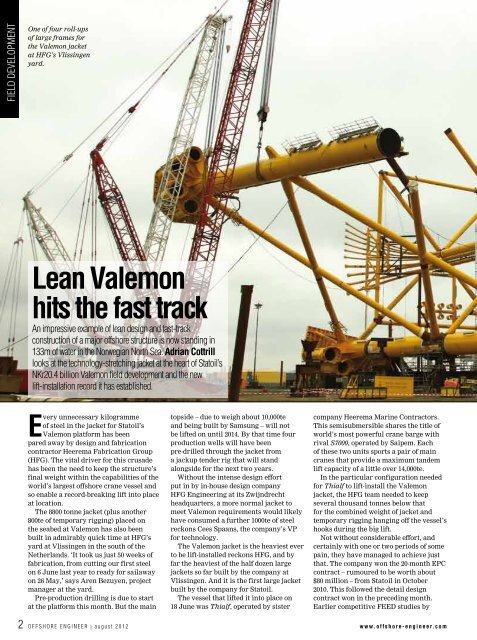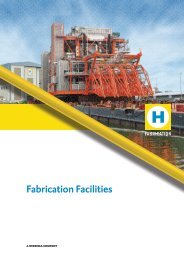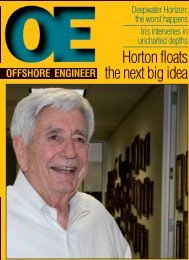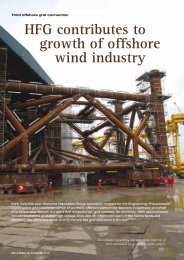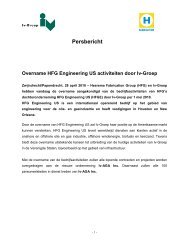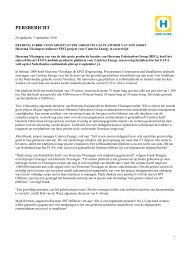Lean Valemon hits the fast track - Heerema Fabrication Group ...
Lean Valemon hits the fast track - Heerema Fabrication Group ...
Lean Valemon hits the fast track - Heerema Fabrication Group ...
You also want an ePaper? Increase the reach of your titles
YUMPU automatically turns print PDFs into web optimized ePapers that Google loves.
FIEld dEvElOpmENt<br />
2<br />
One of four roll-ups<br />
of large frames for<br />
<strong>the</strong> <strong>Valemon</strong> jacket<br />
at HFG’s Vlissingen<br />
yard.<br />
<strong>Lean</strong> <strong>Valemon</strong><br />
<strong>hits</strong> <strong>the</strong> <strong>fast</strong> <strong>track</strong><br />
An impressive example of lean design and <strong>fast</strong>-<strong>track</strong><br />
construction of a major offshore structure is now standing in<br />
133m of water in <strong>the</strong> Norwegian North Sea. Adrian Cottrill<br />
looks at <strong>the</strong> technology-stretching jacket at <strong>the</strong> heart of Statoil’s<br />
NKr20.4 billion valemon field development and <strong>the</strong> new<br />
lift-installation record it has established.<br />
Every unnecessary kilogramme<br />
of steel in <strong>the</strong> jacket for Statoil’s<br />
<strong>Valemon</strong> platform has been<br />
pared away by design and fabrication<br />
contractor <strong>Heerema</strong> <strong>Fabrication</strong> <strong>Group</strong><br />
(HFG). The vital driver for this crusade<br />
has been <strong>the</strong> need to keep <strong>the</strong> structure’s<br />
final weight within <strong>the</strong> capabilities of <strong>the</strong><br />
world’s largest offshore crane vessel and<br />
so enable a record-breaking lift into place<br />
at location.<br />
The 8800 tonne jacket (plus ano<strong>the</strong>r<br />
800te of temporary rigging) placed on<br />
<strong>the</strong> seabed at <strong>Valemon</strong> has also been<br />
built in admirably quick time at HFG’s<br />
yard at Vlissingen in <strong>the</strong> south of <strong>the</strong><br />
Ne<strong>the</strong>rlands. ‘It took us just 50 weeks of<br />
fabrication, from cutting our first steel<br />
on 6 June last year to ready for sailaway<br />
on 26 May,’ says Aren Bezuyen, project<br />
manager at <strong>the</strong> yard.<br />
Pre-production drilling is due to start<br />
at <strong>the</strong> platform this month. But <strong>the</strong> main<br />
topside – due to weigh about 10,000te<br />
and being built by Samsung – will not<br />
be lifted on until 2014. By that time four<br />
production wells will have been<br />
pre-drilled through <strong>the</strong> jacket from<br />
a jackup tender rig that will stand<br />
alongside for <strong>the</strong> next two years.<br />
Without <strong>the</strong> intense design effort<br />
put in by in-house design company<br />
HFG Engineering at its Zwijndrecht<br />
headquarters, a more normal jacket to<br />
meet <strong>Valemon</strong> requirements would likely<br />
have consumed a fur<strong>the</strong>r 1000te of steel<br />
reckons Cees Spaans, <strong>the</strong> company’s VP<br />
for technology.<br />
The <strong>Valemon</strong> jacket is <strong>the</strong> heaviest ever<br />
to be lift-installed reckons HFG, and by<br />
far <strong>the</strong> heaviest of <strong>the</strong> half dozen large<br />
jackets so far built by <strong>the</strong> company at<br />
Vlissingen. And it is <strong>the</strong> first large jacket<br />
built by <strong>the</strong> company for Statoil.<br />
The vessel that lifted it into place on<br />
18 June was Thialf, operated by sister<br />
company <strong>Heerema</strong> Marine Contractors.<br />
This semisubmersible shares <strong>the</strong> title of<br />
world’s most powerful crane barge with<br />
rival S7000, operated by Saipem. Each<br />
of <strong>the</strong>se two units sports a pair of main<br />
cranes that provide a maximum tandem<br />
lift capacity of a little over 14,000te.<br />
In <strong>the</strong> particular configuration needed<br />
for Thialf to lift-install <strong>the</strong> <strong>Valemon</strong><br />
jacket, <strong>the</strong> HFG team needed to keep<br />
several thousand tonnes below that<br />
for <strong>the</strong> combined weight of jacket and<br />
temporary rigging hanging off <strong>the</strong> vessel’s<br />
hooks during <strong>the</strong> big lift.<br />
Not without considerable effort, and<br />
certainly with one or two periods of some<br />
pain, <strong>the</strong>y have managed to achieve just<br />
that. The company won <strong>the</strong> 20-month EPC<br />
contract – rumoured to be worth about<br />
$80 million – from Statoil in October<br />
2010. This followed <strong>the</strong> detail design<br />
contract won in <strong>the</strong> preceding month.<br />
Earlier competitive FEED studies by<br />
O F F S H O R E E N G I N E E R | a u g u s t 2 0 1 2 w w w. o f f s h o r e - e n g i n e e r. c o m
HFG and Aker had already established<br />
lift-installation as <strong>the</strong> road ahead for <strong>the</strong><br />
project.<br />
If a jacket is too heavy for this<br />
approach <strong>the</strong> main alternative is to skid<br />
it lengthways into <strong>the</strong> water off a launchbarge.<br />
However, as Cees Spaans points<br />
out, ‘if you can lift-install you should do<br />
so’.<br />
‘Of course, launching is not only an<br />
issue of weight,’ he continues. ‘You need<br />
to have extra strength in <strong>the</strong> jacket to<br />
undergo <strong>the</strong> launch, skid rails on your<br />
barge, along with ballast systems and<br />
buoyancy tanks, and favourable wea<strong>the</strong>r,<br />
all adding to risk.’<br />
Client Statoil has a long pedigree in<br />
lift-installation of big jackets. Indeed<br />
<strong>the</strong> company’s man on <strong>the</strong> job here,<br />
Kjell Arvid Tuen, with <strong>the</strong> title ‘Statoil<br />
representative, <strong>Valemon</strong> jacket EPC’ is<br />
very familiar with <strong>the</strong> concept. He has<br />
been involved with half a dozen such<br />
projects in his 20 years with <strong>the</strong> oil<br />
company.<br />
Ways to lose weight<br />
For <strong>Valemon</strong> <strong>the</strong> sights were always<br />
set on lift-installation, and <strong>the</strong>refore on<br />
minimum structural weight. Spaans lists<br />
some of <strong>the</strong> measures adopted to achieve<br />
that at an offshore location where <strong>the</strong><br />
100-year design wave has a peak height of<br />
28m. (Under this extreme condition it is<br />
calculated <strong>the</strong> platform top will displace<br />
about 750mm laterally.)<br />
High strength steel is one of <strong>the</strong><br />
measures to keep weight down, he says.<br />
Though not particularly unusual, grades<br />
such as 420 and 460 made a helpful<br />
contribution.<br />
‘The weight of anodes required for<br />
corrosion protection has been reduced<br />
by painting <strong>the</strong> whole of <strong>the</strong> jacket,’ he<br />
continues. ‘And <strong>the</strong> diameter of tubular<br />
members is kept as small as possible, only<br />
ballooning out at end connection nodes<br />
where extra strength is needed to meet<br />
fatigue demands.<br />
‘In addition we have braces that are<br />
flooded so <strong>the</strong>y do not have to resist<br />
hydrostatic collapse.’ This is not normal<br />
practice because buoyant braces lend<br />
<strong>the</strong>mselves to flood detection systems<br />
to indicate fatigue damage, but is an<br />
acceptable trade-off here. Also, ‘instead of<br />
designing in additional strength to meet<br />
demands during <strong>the</strong> temporary transport<br />
phase at sea, we have dealt with that in<br />
o<strong>the</strong>r ways’, says Spaans. For example,<br />
a system of bracing wires to <strong>the</strong> inner<br />
members dampened any tendency for<br />
<strong>the</strong>m to vibrate in high winds.<br />
Once HMC won <strong>the</strong> installation<br />
contract, that phase could be designed<br />
specifically around Thialf. One of <strong>the</strong><br />
differences from S7000 for example<br />
is that Thialf’s main hook is allowed<br />
underwater, avoiding <strong>the</strong> need to find<br />
w w w. o f f s h o r e - e n g i n e e r. c o m O F F S H O R E E N G I N E E R | a u g u s t 2 0 1 2<br />
courtesy heerema<br />
3<br />
FIEld dEvElOpmENt
FIEld dEvElOpmENt<br />
4<br />
adrian cottrill<br />
adrian cottrill<br />
extra buoyancy to avoid that limitation.<br />
Above all, says Spaans, ‘we worked<br />
steadily towards our weight target by<br />
doing far more than <strong>the</strong> normal one or<br />
two cycles of engineering to get weight<br />
down. We analysed again and again and<br />
again.’<br />
Both Spaans and Bezuyen speak of<br />
<strong>the</strong> benefits of having so many aspects<br />
of <strong>the</strong> whole project within <strong>the</strong> <strong>Heerema</strong><br />
group and <strong>the</strong> quality of <strong>the</strong> resulting<br />
interaction between <strong>the</strong> design and<br />
construction sides. They also underline<br />
<strong>the</strong> very effective communication with<br />
client Statoil and certifying authority<br />
DNV right from <strong>the</strong> beginning.<br />
Statoil’s Kjell Arvid Tuen agrees. His<br />
own involvement with <strong>the</strong> project began<br />
The completed <strong>Valemon</strong> jacket, loaded on<br />
transport barge at Vlissingen yard quayside<br />
sailed away from <strong>the</strong> Ne<strong>the</strong>rlands early<br />
on <strong>the</strong> morning of 26 May.<br />
‘We worked steadily towards our<br />
weight target . . . we analysed<br />
again and again and again’<br />
Cees Spaans, HFG<br />
in <strong>the</strong> very earliest days when <strong>the</strong> design<br />
basis was being evolved. Then, when<br />
<strong>the</strong> contract was awarded, Tuen went on<br />
to spend two years in <strong>the</strong> Ne<strong>the</strong>rlands,<br />
starting in HFG’s design offices and<br />
ending with close to four weeks on board<br />
Thialf for <strong>the</strong> offshore installation.<br />
Clearly he enjoyed <strong>the</strong> experience.<br />
‘The Dutch and Norwegians have <strong>the</strong><br />
same cultural attitudes,’ he says, ‘and<br />
communication has been very effective.<br />
We started working toge<strong>the</strong>r from day<br />
one of <strong>the</strong> contract, and that’s one of <strong>the</strong><br />
reasons for <strong>the</strong> success I think.’<br />
Two challenging issues<br />
Certainly <strong>the</strong> emphasis on lean design,<br />
with maximum input as early as possible,<br />
courtesy heerema<br />
The dominant design factors for HFG at<br />
various points of <strong>the</strong> jacket are shown<br />
below.<br />
In place – Strength<br />
In place – Fatigue<br />
Accidental – Boat impact<br />
temporary – lift and transport<br />
O F F S H O R E E N G I N E E R | a u g u s t 2 0 1 2 w w w. o f f s h o r e - e n g i n e e r. c o m<br />
courtesy heerema
adrian cottrill<br />
paid useful dividends, says Cees Spaans.<br />
However, it did not prevent <strong>the</strong> design<br />
process going through a couple of painful<br />
periods.<br />
The first of <strong>the</strong>se came during design<br />
of <strong>the</strong> two mighty trunnion nodes in<br />
<strong>the</strong> jacket’s lower legs. These huge steel<br />
castings, weighing 110te each, formed <strong>the</strong><br />
all-important pivot points when <strong>the</strong> jacket<br />
was dangling from Thialf’s hooks during<br />
installation offshore and was rotated from<br />
horizontal to vertical.<br />
Built by specialist company Vulcan<br />
Sheffield Forgemasters, <strong>the</strong>y are <strong>the</strong><br />
largest cast nodes ever produced. ‘The<br />
challenge of designing <strong>the</strong>se castings was<br />
definitely a little bit underestimated,’<br />
concedes Spaans. ‘In fact in <strong>the</strong> end it<br />
took us nearly three months instead of<br />
<strong>the</strong> two or three weeks expected.’<br />
‘The rotating hub is a very tight fit –<br />
with just 3mm of clearance,’ he explains,<br />
‘and <strong>the</strong> challenge was to prevent it<br />
deforming too much under load.’ There<br />
are also ano<strong>the</strong>r two smaller cast nodes at<br />
<strong>the</strong> lift points in <strong>the</strong> upper legs. Happily<br />
<strong>the</strong>se proved less difficult to design.<br />
Not long after this <strong>the</strong> designers<br />
encountered ano<strong>the</strong>r unpleasant surprise.<br />
In autumn last year <strong>the</strong>y discovered that<br />
in <strong>the</strong>ir bid to get <strong>the</strong> thinnest possible<br />
steel wall in <strong>the</strong> main legs, those legs had<br />
been left too weak to prevent deformation<br />
during <strong>the</strong> sea journey at two of <strong>the</strong> main<br />
support points on <strong>the</strong> grillage aboard <strong>the</strong><br />
transport barge.<br />
The only solution at this stage was<br />
to add local streng<strong>the</strong>ning. Just over<br />
40 ring stiffeners were welded inside<br />
<strong>the</strong> 3.5m diameter lower legs at <strong>the</strong> two<br />
affected points. This brought <strong>the</strong> triple<br />
inconveniences of about 60te of extra<br />
steel weight, a large amount of planning,<br />
and ‘a tremendous lot of hours needed<br />
to weld <strong>the</strong>m in’. However, ‘that’s all<br />
part of <strong>the</strong> EPC risk’, observes Spaans<br />
philosophically.<br />
A fur<strong>the</strong>r area of challenge for both<br />
designers and fabricators was <strong>the</strong> grillage<br />
and sea-<strong>fast</strong>ening for <strong>the</strong> journey to <strong>the</strong><br />
offshore location. The demanding North<br />
Sea environment to be designed for (a<br />
maximum wave height of nearly 11m<br />
during sea transport) meant high loads<br />
and large reactions between barge and<br />
jacket. It was difficult to find an example<br />
‘It took us just fifty weeks<br />
of fabrication, from<br />
cutting our first steel to<br />
being ready for sailaway.’<br />
Aren Bezuyen, HFG<br />
from a different project and ‘that was a<br />
challenge we solved toge<strong>the</strong>r with HMC’,<br />
says Spaans.<br />
‘What did go very well was <strong>the</strong> whole<br />
certification process,’ he notes. ‘I thought<br />
<strong>the</strong> main challenge would be to meet<br />
fatigue criteria with DNV, not least<br />
because when different organisations do<br />
<strong>the</strong> same analysis, <strong>the</strong>y are bound to use<br />
different kinds of software.’<br />
However, <strong>the</strong> verification process with<br />
DNV went amazingly smoothly, he says.<br />
‘This was a lot to do with <strong>the</strong>m being<br />
involved early.’<br />
Boat impact and foundations<br />
Designing against boat impact is clearly<br />
ano<strong>the</strong>r area where HFG is proud of its<br />
efforts. ‘This generated a very interesting<br />
technical discussion,’ notes Spaans.<br />
The criteria for <strong>Valemon</strong> are unusually<br />
high. Because <strong>the</strong> platform sits in a<br />
shipping lane it could potentially be hit<br />
by vessels as big as a large supply boat<br />
weighing up to 7500te and moving at up<br />
to 5 knots. In addition, a vessel like that<br />
can have more complicated aspects to its<br />
shape, such as a bulb at <strong>the</strong> bow, which<br />
influence <strong>the</strong> way it could penetrate a<br />
platform.<br />
In more standard locations, <strong>the</strong><br />
One of <strong>the</strong> two<br />
huge trunnion<br />
nodes cast<br />
by Vulcan<br />
Sheffield<br />
Forgemasters.<br />
requirements are based on a 5000te<br />
vessel moving at up to 4 knots. All this<br />
translates into <strong>Valemon</strong> having to cater<br />
for 35MJ of impact energy. This figure is<br />
close to three times what is more usually<br />
called for.<br />
‘In general, you want <strong>the</strong> jacket to be as<br />
open as possible to minimise wave load,’<br />
Spaans points out. ‘But in <strong>the</strong> area where<br />
a boat could impact (between about 12m<br />
above and below water level) members<br />
need to be more closely packed to prevent<br />
a boat penetrating too far into <strong>the</strong> jacket.<br />
‘Industry guidelines are based simply<br />
on impact energy and point load,’ he says.<br />
‘They don’t look at <strong>the</strong> physical shape of<br />
<strong>the</strong> boat, nor where you can enter or what<br />
you can hit.’<br />
‘So we engaged in a more probabalistic<br />
approach to define <strong>the</strong> real challenge and<br />
find <strong>the</strong> right balance. We went through<br />
a question and answer process, asking<br />
ourselves just how far a boat could<br />
penetrate into <strong>the</strong> body of <strong>the</strong> jacket.’<br />
To do this, HFG engaged in ‘a very<br />
sophisticated study’ jointly with Dutch<br />
research organisation TNO which has<br />
done considerable work in this field. At<br />
<strong>the</strong> same time Statoil undertook a similar<br />
study through Trondheim’s University of<br />
Science & Technology. > overleaf<br />
All rigged up in <strong>the</strong> yard: huge slings in place round one of <strong>the</strong> pair of trunnion nodes<br />
that provide vital pivot points for rotation. The sling is made of steel rope of nearly<br />
300mm diameter and over 6500te breaking strength.<br />
w w w. o f f s h o r e - e n g i n e e r. c o m O F F S H O R E E N G I N E E R | a u g u s t 2 0 1 2<br />
adrian cottrill<br />
5<br />
FIEld dEvElOpmENt
FIEld dEvElOpmENt<br />
8<br />
courtesy heerema<br />
<strong>the</strong> valemon field<br />
<strong>the</strong> valemon gas and condensate<br />
accumulation, a 1985 discovery 160km<br />
off <strong>the</strong> coast from Bergen, has estimated<br />
recoverable reserves equivalent to<br />
210 million barrels of oil. development<br />
is currently priced at NKr20.4 billion by<br />
operator Statoil and its partners petoro,<br />
Centrica and Enterprise.<br />
<strong>the</strong> valemon platform is designed to<br />
In <strong>the</strong> platform’s foundations one<br />
novelty is <strong>the</strong> inclusion of cages of 16mm<br />
steel reinforcing bar within <strong>the</strong> annulus<br />
of grout that connects each pile to its<br />
sleeve once it has been driven. This is<br />
part of <strong>the</strong> latest DNV codes on grouted<br />
connections.<br />
The jacket stands on a group of four<br />
84in diameter piles at <strong>the</strong> base of each of<br />
its four main legs. These piles are driven<br />
59m into <strong>the</strong> medium seabed soil at this<br />
site.<br />
produce about 85,000boe/d. <strong>the</strong> bulk of<br />
reserves – about 80% – take <strong>the</strong> form<br />
of natural gas, with <strong>the</strong> remainder as<br />
condensate and natural gas liquids.<br />
two years of pre-drilling is due to start this<br />
month to provide four of <strong>the</strong> 11 production<br />
wells currently planned, using a jackup tender<br />
rig standing alongside <strong>the</strong> jacket and <strong>the</strong> small<br />
wellhead module placed on it. <strong>the</strong>re will also<br />
be two injection wells – one for drill cuttings<br />
and <strong>the</strong> o<strong>the</strong>r for produced water.<br />
Design codes now require steel bar reinforcement in <strong>the</strong> grout<br />
annulus in <strong>the</strong> pile to sleeve connection.<br />
Wellhead module<br />
To cater for <strong>the</strong> pre-drilling operations due to<br />
run for two years from July until <strong>the</strong> platform’s<br />
main topside arrives, <strong>the</strong> <strong>Valemon</strong> jacket carries<br />
a wellhead module which will later be partly<br />
integrated into <strong>the</strong> main topsides. This has<br />
also been designed and built by HFG in just six<br />
months, fabricating at a smaller yard near its main<br />
Vlissingen site.<br />
Athough relatively small, at 190te, 25m long<br />
and just 3m high, it was also not without its<br />
challenges. Rapid action had to be taken last<br />
October when Statoil called for <strong>the</strong> design to be<br />
completely changed: from two-deck to single<br />
deck. Also, to enable adjustments when <strong>the</strong> main<br />
topside arrives in two years, it is fixed by some<br />
2000 bolts because of <strong>the</strong> ban on hot work once<br />
drilling has started.<br />
In mid-2014 <strong>the</strong> topside being built<br />
by Samsung, and likely to weigh about<br />
10,000te, will be lifted on. <strong>the</strong> completed<br />
platform is due onstream by <strong>the</strong> end of<br />
that year. It will be able to treat gas and<br />
condensate from future discoveries in <strong>the</strong><br />
area as well as valemon itself.<br />
<strong>the</strong> installation is classed as ‘not<br />
normally manned’ once drilling is<br />
completed, although it will have 40 cabins<br />
of accommodation. It will be remotely<br />
The move to add rebar cages to <strong>the</strong><br />
grout follows a certain amount of<br />
trouble with foundations in <strong>the</strong> offshore<br />
wind sector, perhaps too economically<br />
designed. There are reports of grout<br />
‘crunching’ and tube damage. In effect <strong>the</strong><br />
addition of rebar cages turns <strong>the</strong> grout<br />
layer into straightforward reinforced<br />
concrete.<br />
In <strong>the</strong> yard<br />
Summarising <strong>the</strong> jacket construction<br />
work at Vlissingen, HFG project manager<br />
Aren Bezuyen describes <strong>the</strong> rapid pace<br />
of early procurement on this <strong>fast</strong>-<strong>track</strong><br />
project as ‘especially necessary with<br />
certain specialist suppliers like Vulcan<br />
Sheffield Forgemasters for <strong>the</strong> highlydemanding<br />
cast nodes’. He also outlines<br />
<strong>the</strong> weight uncertainties and puzzles<br />
confronted as fabrication proceeded. ‘We<br />
did as much work as possible at ground<br />
level, building <strong>the</strong> jacket in four main<br />
parts which could be rolled up,’ says<br />
Bezuyen. The heaviest lifts at height were<br />
two 400te leg base sections. Late delivery<br />
in certain areas meant that ‘we had to<br />
do more work at height than we’d hoped.<br />
For example we were not able to get all<br />
<strong>the</strong> risers and caissons in place before<br />
roll-up.’<br />
Ano<strong>the</strong>r delaying factor, he adds,<br />
was <strong>the</strong> information provided by HMC,<br />
controlled from <strong>the</strong> Kvitebjorn platform<br />
11km away, which will also supply power by<br />
cable. Kvitebjorn will also be <strong>the</strong> recipient<br />
of valemon’s condensate via a new pipeline<br />
between <strong>the</strong> two, with onward transport<br />
through <strong>the</strong> existing network to mongstad<br />
refinery.<br />
<strong>the</strong> main flow of rich gas from valemon<br />
will go through a new 27km pipe to connect<br />
with an existing line and <strong>the</strong>n be transported<br />
onward to Heimdal.<br />
One of <strong>the</strong> main support points on <strong>the</strong> transport barge. Ring<br />
stiffeners had to be added inside <strong>the</strong> jacket legs at two such points.<br />
<strong>the</strong>mselves wrestling with a jacket that<br />
was bringing Thialf to <strong>the</strong> limits of its<br />
capacity. But after less than a year of<br />
physical construction work, all was ready<br />
by mid-May for <strong>the</strong> completed jacket to<br />
start moving from <strong>the</strong> yard. In a two-part<br />
operation <strong>the</strong> combination of jacket,<br />
support grillage and temporary<br />
attachments (a total load of 10,790te) was<br />
first moved 35m sideways by load-out<br />
subcontractor Mammoet on a massive<br />
wheeled array of 400 axles. > overleaf<br />
In <strong>the</strong> drive to minimise steel weight, jacket<br />
braces only balloon out in diameter at <strong>the</strong>ir<br />
ends to meet fatigue requirements at nodes.<br />
O F F S H O R E E N G I N E E R | a u g u s t 2 0 1 2 w w w. o f f s h o r e - e n g i n e e r. c o m<br />
adrian cottrill adrian cottrill
FIEld dEvElOpmENt<br />
10<br />
courtesy woldcam as, anette westgård<br />
‘Effective<br />
communication a<br />
major reason for<br />
project success’<br />
Kyell Arvid Tuen,<br />
Statoil<br />
Then it was moved 160m forwards<br />
onto <strong>the</strong> barge which would take it to<br />
location. Total rolling time was about<br />
five hours. Next came ten days of fixing<br />
sea-<strong>fast</strong>enings, guy-lines to braces and<br />
suchlike, leading up to sailaway of barge<br />
and cargo early on 26 May.<br />
Altoge<strong>the</strong>r HFG’s <strong>Valemon</strong> jacket<br />
project has notched up half a million<br />
manhours. A fifth of that was divided<br />
equally between engineering and<br />
management. Ano<strong>the</strong>r fifth was by<br />
subcontractors.<br />
The remaining 300,000 manhours<br />
went to fabrication in <strong>the</strong> Vlissingen<br />
yard.<br />
Statoil’s Tuen sums it up. ‘The big goal<br />
right from <strong>the</strong> start was of course to make<br />
<strong>the</strong> jacket liftable,’ he says, ‘and in my<br />
mind HFG has done a very good job, both<br />
technically and commercially.’<br />
He has sympathy with HFG over <strong>the</strong><br />
difficult stages it had to overcome. ‘It’s<br />
always good to finish as much analysis<br />
as possible before you order steel. But it’s<br />
also important to work as <strong>fast</strong> as possible.<br />
I think HFG did as well as <strong>the</strong>y could.<br />
They had to finish by a certain date, so<br />
<strong>the</strong>y had to order <strong>the</strong> steel in <strong>the</strong> way <strong>the</strong>y<br />
did.’<br />
As to value for money, Tuen reckons<br />
‘<strong>Valemon</strong> is more or less <strong>the</strong> best we’ve<br />
had. This was helped by our timing in<br />
<strong>the</strong> market, but also by <strong>the</strong> fact that<br />
HFG wanted to show Statoil <strong>the</strong>y were a<br />
professional jacket EPC contractor.<br />
‘It’s <strong>the</strong> first <strong>the</strong>y have ever built for us,<br />
and now we have no doubt that <strong>the</strong>y can<br />
do it.’<br />
Statoil’s vice president for <strong>Valemon</strong>,<br />
Bjørn Laastad, notes: ‘We are very<br />
pleased with this delivery from <strong>Heerema</strong><br />
<strong>Fabrication</strong> <strong>Group</strong>, which is a new<br />
supplier to Statoil for steel jackets of this<br />
size.’<br />
As <strong>the</strong> bright yellow jacket sailed away<br />
in <strong>the</strong> pale dawn light on 26 May, both<br />
<strong>the</strong> designers and <strong>the</strong> builders in HFG<br />
could reflect on a good job done. They had<br />
derived all <strong>the</strong> in-house advantages <strong>the</strong>y<br />
could in integrating <strong>the</strong> engineering and<br />
fabrication processes, placed<br />
fruitful emphasis on constructability,<br />
and been greatly aided by effective<br />
communication with <strong>the</strong>ir client Statoil<br />
and partners. OE<br />
Lift-installation’s<br />
latest benchmark<br />
After two weeks of waiting on<br />
wea<strong>the</strong>r, Thialf could at last get to<br />
work on <strong>the</strong> <strong>Valemon</strong> jacket.<br />
O F F S H O R E E N G I N E E R | a u g u s t 2 0 1 2 w w w. o f f s h o r e - e n g i n e e r. c o m
w w w. o f f s h o r e - e n g i n e e r. c o m O F F S H O R E E N G I N E E R | a u g u s t 2 0 1 2<br />
courtesy woldcam as, anette westgård<br />
courtesy heerema<br />
All <strong>the</strong> careful planning and<br />
refinement of <strong>the</strong> <strong>Valemon</strong> jacket<br />
design finally paid off on 18 June<br />
when <strong>the</strong> structure’s record-breaking<br />
offshore lift-installation was completed.<br />
At 03.00 hours, <strong>the</strong> base of <strong>the</strong> 160m high<br />
steel frame finally touched <strong>the</strong> seabed, on<br />
target and perfectly upright.<br />
The sequence had started with vessel<br />
operator HMC first bringing <strong>the</strong> transport<br />
barge into position at <strong>the</strong> stern of Thialf.<br />
Then, with <strong>the</strong> twin cranes hooked to <strong>the</strong><br />
jacket’s pre-installed lifting slings, <strong>the</strong><br />
transport barge could be slowly ballasted<br />
lower in <strong>the</strong> water, sea <strong>fast</strong>enings cut and<br />
<strong>the</strong> jacket raised above its deck.<br />
Once <strong>the</strong> free-floating cargo barge had<br />
been towed away, <strong>the</strong> bottom end of <strong>the</strong><br />
jacket could be steadily lowered into <strong>the</strong><br />
water, with <strong>the</strong> structure just as steadily<br />
rotating from horizontal to vertical as it<br />
went.<br />
The procedure did however suffer a late<br />
interruption when a mechanical problem<br />
stopped one of <strong>the</strong> main cranes and<br />
caused <strong>the</strong> whole lift operation to halt.<br />
At that point <strong>the</strong> jacket had been fully<br />
rotated but still had ano<strong>the</strong>r 7m to go to<br />
reach <strong>the</strong> seabed 133m below water. So<br />
<strong>the</strong> last stage of set-down was achieved by<br />
a combination of booming down <strong>the</strong> crane<br />
and ballasting of Thialf.<br />
Thirteen days later, HMC had stabbed,<br />
driven and grouted all 16 foundation piles<br />
and finished with <strong>the</strong> small lifts of five<br />
caissons and <strong>the</strong> 190te wellhead module.<br />
On 1 July <strong>the</strong> vessel was able to sail away<br />
from a highly demanding job well done<br />
for client Statoil.<br />
Waiting on wea<strong>the</strong>r<br />
The immediate run-up to this, <strong>the</strong> world’s<br />
heaviest lift-installation, had been a stark<br />
contrast to all that activity. Before <strong>the</strong>y<br />
were at last able to swing into action,<br />
<strong>the</strong> team onboard Thialf had to sit out a<br />
frustrating 15 days of inactivity, waiting<br />
on wea<strong>the</strong>r and hoping for sea conditions<br />
to calm down enough for <strong>the</strong>m to start <strong>the</strong><br />
delicate jacket lift.<br />
When that window did open, says HMC<br />
project manager Carol Granneman, ‘<strong>the</strong><br />
wea<strong>the</strong>r was excellent. It was very quiet,<br />
with seas of less than half a metre and<br />
hardly any wind, and that helped us a lot.’<br />
The total load on <strong>the</strong> hooks of Thialf’s<br />
11<br />
FIEld dEvElOpmENt
FIEld dEvElOpmENt<br />
12<br />
twin cranes as <strong>the</strong> jacket rose off its<br />
transport barge was 9600te. This included<br />
some 800te of temporary equipment such<br />
as spreader bars and slings.<br />
Thialf has lifted heavier loads than this<br />
a number of times in <strong>the</strong> past. Largest of<br />
<strong>the</strong>se to date has been <strong>the</strong> 11,800te topside<br />
for <strong>the</strong> Shearwater platform in <strong>the</strong> UK<br />
North Sea, placed in 2000.<br />
But a large jacket is a ra<strong>the</strong>r different<br />
proposition. It may not be as susceptible<br />
to wind forces as a big topside, but it does<br />
call for <strong>the</strong> delicate and complicated task<br />
of rotating from horizontal to vertical<br />
once it has been raised from <strong>the</strong> transport<br />
barge.<br />
That lift-off is just as delicate, governed<br />
by <strong>the</strong> relative motion between crane<br />
vessel and <strong>the</strong> transport barge brought<br />
beneath its cranes. ‘Every lift has its own<br />
limits,’ says Granneman, ‘and this one<br />
had probably <strong>the</strong> most stringent limits we<br />
have seen.’<br />
<strong>Valemon</strong> called for sea conditions<br />
below 2m significant wave height. ‘In <strong>the</strong><br />
event we experienced no more than half<br />
that,’ he says. ‘That put us well within<br />
crane limits, still with spare capacity left.’<br />
The movement at crane tips was probably<br />
less than 100mm.<br />
Wea<strong>the</strong>r during <strong>the</strong> preceding 15 days<br />
of standby time was poor ra<strong>the</strong>r than<br />
dramatically bad as Thialf waited on<br />
location and <strong>the</strong> jacket stood off about<br />
5km. ‘The most exciting part of <strong>the</strong> day<br />
was <strong>the</strong> wea<strong>the</strong>r forecaster’s presentation<br />
on what he expected for <strong>the</strong> next week,’<br />
says Granneman.<br />
‘We had one instance where we thought<br />
<strong>the</strong> lift could be possible and got ourselves<br />
ready,’ he continues. ‘But actual<br />
Slowly rotating, <strong>the</strong> lower end<br />
of <strong>the</strong> jacket descends into <strong>the</strong><br />
water. Right: Landed on <strong>the</strong><br />
seabed, <strong>the</strong> jacket awaits <strong>the</strong><br />
first of <strong>the</strong> 16 foundation piles<br />
in foreground to be stabbed<br />
and driven. Below: Hooking<br />
up in a calm sea for a<br />
record-breaking lift.<br />
conditions turned out a little worse than<br />
expected and we had to postpone. You<br />
can’t do anything about <strong>the</strong> wea<strong>the</strong>r.’<br />
When a viable five-day window did<br />
come into view HMC could at<br />
last spring into action.<br />
Once <strong>the</strong> jacket had<br />
been landed on <strong>the</strong> seabed,<br />
foundation work went <strong>fast</strong>er<br />
than expected. About a day<br />
was trimmed from <strong>the</strong> nineday<br />
schedule for driving with<br />
<strong>the</strong> big Menck MHU 2100<br />
underwater hammer and<br />
grouting <strong>the</strong> skirt piles.<br />
Installation of <strong>the</strong> wellhead<br />
module also went well.<br />
‘Our colleagues at <strong>Heerema</strong><br />
<strong>Fabrication</strong> <strong>Group</strong> did a<br />
terrific job in aligning all<br />
those boltholes for connecting to <strong>the</strong><br />
jacket,’ Granneman remarks.<br />
The ‘in-house’ combination of all<br />
aspects from design to installation of <strong>the</strong><br />
<strong>Valemon</strong> jacket – divided between sister<br />
companies HFG and HMC – bore fruit<br />
right from <strong>the</strong> start.<br />
Once Thialf was chosen as installation<br />
vessel, <strong>the</strong> jacket design could be tailored<br />
even more precisely. One difference<br />
from rival vessel S7000 is that <strong>the</strong> blocks<br />
of Thialf’s main cranes are allowed<br />
underwater, even if that does mean a<br />
substantial job of cleaning and greasing<br />
afterwards. In <strong>the</strong> procedure chosen, one<br />
block went about 30m underwater.<br />
As for <strong>the</strong> two large trunnion nodes<br />
that proved such a headache to design,<br />
‘<strong>the</strong> jacket turned very smoothly’, says<br />
Granneman. He also mentions that<br />
because <strong>the</strong> planned operation was so<br />
close to Thialf’s limits, <strong>the</strong> option was<br />
kept open to place counterweights on <strong>the</strong><br />
very top of <strong>the</strong> jacket to modify <strong>the</strong> load<br />
distribution between <strong>the</strong> two cranes. In<br />
<strong>the</strong> end that was not called<br />
for.<br />
‘Small things can have<br />
a great impact on <strong>the</strong><br />
whole operation,’ says<br />
Granneman. He quotes<br />
<strong>the</strong> example of a flooding<br />
pipe whose position could<br />
interfere with <strong>the</strong> piledriving<br />
hammer. ‘We just<br />
adjusted our work method<br />
a little to allow that pipe to<br />
stay <strong>the</strong>re.’ Similarly it was<br />
agreed that guide pins on<br />
<strong>the</strong> top of <strong>the</strong> jacket could be<br />
included in <strong>the</strong> lift and be a<br />
helpful influence on centre of gravity.<br />
<strong>Valemon</strong> has taken jacket<br />
lift-installation procedures ano<strong>the</strong>r<br />
impressive step forward with completion<br />
of this lump sum contract from Statoil,<br />
rumoured to be worth about E150 million.<br />
There may not be any more big jacket<br />
lift-installation operations coming up<br />
this year, but clearly <strong>the</strong> technique will<br />
continue to be seen on some impressively<br />
heavy structures. Right now, Statoil’s<br />
representative through <strong>the</strong> whole<br />
<strong>Valemon</strong> jacket EPC – Kjell Arvid Tuen –<br />
is moving to <strong>the</strong> Dagny project.<br />
Dagny, says Tuen, ‘has a heavier<br />
topside, so <strong>the</strong> jacket is even closer to<br />
<strong>the</strong> maximum lift capacity of <strong>the</strong> two big<br />
crane vessels in <strong>the</strong> market. We are just<br />
about to take a decision on whe<strong>the</strong>r we<br />
should choose lift-installation or bargelaunch<br />
for Dagny.’ OE<br />
O F F S H O R E E N G I N E E R | a u g u s t 2 0 1 2 w w w. o f f s h o r e - e n g i n e e r. c o m<br />
courtesy heerema<br />
courtesy heerema<br />
courtesy woldcam as, anette westgård


